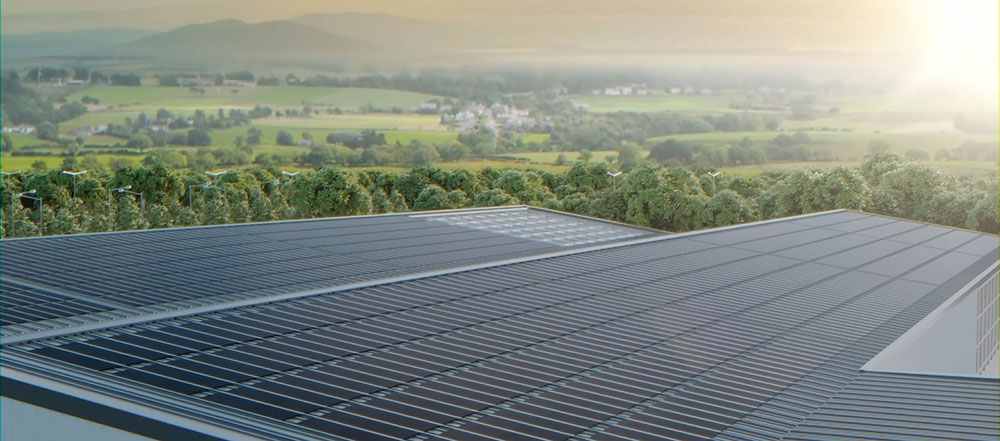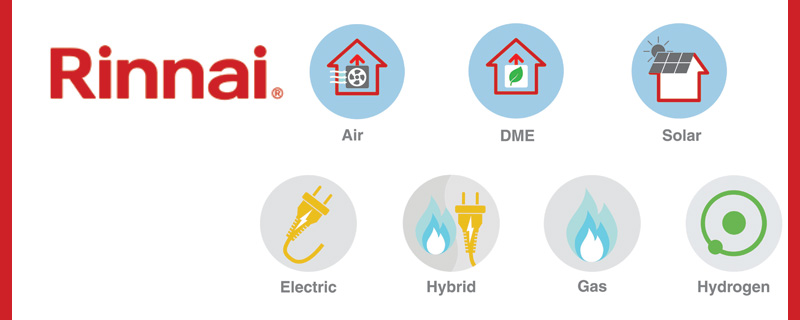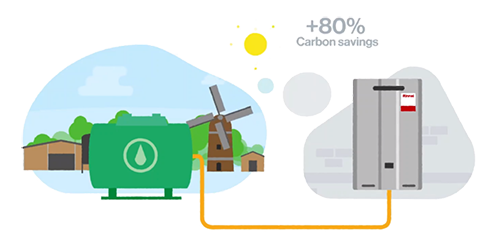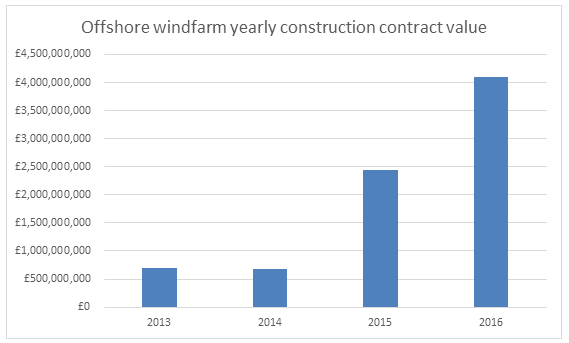LOGICAL THINKING MAKES RINNAI’s
H1 – Hydrogen / BioLPG ready – H2 – Hybrid Solar Thermal and heat pump – H3 LOW-GWP heat pumps
THE informed CHOICE

Chris Goggin argues that when logically thinking of current UK national energy legislation, Rinnai’s range of H3 products can deliver all commercial, domestic and off-grid properties heating and hot water solutions. Rinnai’s H3 range is well placed to deliver heating and hot water to all UK sites that are interested in low-cost decarbonisation.
[Visit www.rinnaiuk.co.uk or call 0300 373 0660 to find out more]
UK customers of energy and energy related products are presently experiencing increased levels of financial turbulence. UK energy policy stipulates that fossil fuels will be gradually withdrawn from power options and renewable energy alternatives being used in replacement.
The UK government views renewable sources of energy as cost-effective and sustainable. When thinking of investing in a heating or hot water system for a domestic or commercial property it is worth pausing to consider current and future legislative direction.
As fossil fuels are targeted for actively being phased out of circulation, seeking a decarbonising heating and hot water system has become a prominent issue to UK customers. UK customers must now think logically when considering future energy and energy related products.
Current domestic UK policy is keen on expanding on and offshore wind farms for electrical generation. Construction of on and offshore wind farms are continuing with several beginning operations soon, or have already started production, such as Triton Knoll and Hornsea 2.
Only recently wind farms across the UK have set a record for secondary power generation. National Grid ESO said that during a 30-minute period on the 2nd of November, wind farms accounted for 53% of Britain’s electricity. The previous record was set last week when 19,936MW of electricity was provided towards national demand by on and offshore wind farms in a half hour period.
UK acceptance of renewable wind farms has been gradually growing since initial introduction in the 1980s. Communities strongly opposed plans to install wind farms as they were viewed as distorting natural scenery and therefore potentially affecting house prices.
Since the 1980s a climate emergency has been imposed and energy costs have reached exorbitant levels. A survey taken by RenewableUK demonstrates that the UK public now overwhelmingly supports the installation of new solar, wind (on and offshore) and wave power facilities to tackle on-going issues relating to the cost-of-living crises and energy costs.
RenewableUK gathered the following results when asking if the public was in favour of renewable energy installations that reduce electricity bills: 81% were in favour of solar energy, 76% of people backed offshore wind, 74% in favour of onshore wind and 72% support tidal and wave power.
To protect UK customers against market volatility and enhance domestic energy security, the UK government must seek alternative and sustainable methods of energy cultivation. As a result, renewable sources of energy will be steadily introduced into the UK domestic energy mix.
Public support and relaxed legislation will see renewable energy production and dispersal become widespread. Rinnai hold a selection of products capable of fulfilling any UK customer requirements regarding the purchase of a decarbonising heating and hot water system.
Rinnai’s H3 range includes all mainstream varieties of renewable energy alternative options including, solar thermal, heat pumps, Bio LPG water heaters and boilers and solar thermal tube collectors. All options focus on decarbonisation and reducing customer cost across all stages of product life cycle.

Rinnai can offer multiple avenues of cost reducing decarbonisation across various energy vectors. To create a healthier way of living, Rinnai is offering customer choices in hot water provision as well as heating domestic and commercial buildings through a wide range of renewable energy systems.
Rinnai’s solar thermal water heating systems are a decarbonising commercial option. Rinnai’s Solar thermal VirtuHOT units are designed and manufactured in conjunction with Naked Energy. Core design values of VirtuHOT has benefited from multiple workshops with experienced installers, whose valuable insights have been integrated into design and innovation. VirtuHOT saves up to 3.5x more carbon per m2 compared to conventional solar technology.
Rinnai’s H3 range of decarbonising products include commercial and domestic heat pumps that contain a variety of features: the HPIH range of commercial heat pumps is suited towards schools, restaurants and small retail outlets. Rinnai’s HPIH Monobloc Air Source Heat Pumps – 21, 26, 28 & 32kW range can allow for up to seven units to be cascaded together or operate alone as one unit. Once joined together – can serve increased demand for heating and hot water.
The HPIH series includes a range of controls and system peripherals which ensures that all technical machinations can be monitored. Rinnai’s HPIH commercial heat pumps also deploy the refrigerant – R32, which contains a low GWP. The HPIH use maintains an ERP rating of A++ making this range of heat pumps an ideal economic and environmental option for refurbishment projects.
Rinnai’s HPHP series of domestic heat pumps arrive with the ability to save up to 25% of power input, enhancing efficiency and operational performance. State-of-the-art technology added in the injection process outperforms gas compression technology and ensures that even with outside temperatures of –25 Celsius, heating and hot water of up to 60 + Celsius can still be delivered.
Rinnai’s HPI SL range models perform with ultra-low sound capability ensuring compatibility with areas that hold strict sound compliance standards. All units operate in three different modes: heating, cooling and DHW. All three models include specific system programmes that enhances product performance in all modes.
UK energy policy is aimed towards long term renewable energy production that is sustainable and free from outside malign market influences. Logical thinking infers that the UK customer must begin considering investing in decarbonising renewable heating and hot water provision. For more information and details contact
RINNAI H3 PRODUCT ROADMAP TO LOWER CARBON AND NET ZERO DE-CARBONISATION
Rinnai’s product and service offering is based on H3- Hydrogen, Heating and Heat Pumps – which allows any site in either residential or commercial sites to maximise the energy efficiency and performance in striving for NetZero and Decarbonisation. Additionally, Rinnai is developing and introducing electrical formats to all existing product ranges within the next few months. Rinnai’s new “H3” range of products includes a wide selection of commercial heat pumps as well as hydrogen blends-ready and hybrid hot water heating systems.
Rinnai is a world leading manufacturer of hot water heaters and produces over two million units a year. The company operates on each of the five continents and the brand has gained an established reputation for high performance, robust cost efficiency and extended working lives.
Rinnai’s commercial and domestic hot water products offer a limitless supply of instantaneous temperature controlled hot water and all units are designed to align with present and future energy sources and accept either natural gas or hydrogen gas blends. Rinnai units are also suited for off-grid customers who require LPG and BioLPG or rDME.
Rinnai units are UKCA certified, A-rated water efficiency, accessed through multiple fuel options and are available for purchase 24/7, 365 days a year. Any unit can be delivered to any UK site within 24 hours. System design services are available if needed and cost comparison services are accessible to all customers who require further cost detail.
Rinnai’s Innovation Manifesto clearly outlines the path to carbon neutrality and maintains a pledge to fully decarbonize company operations by 2050. Rinnai will further support the global clean energy transition by introducing a wide variety of domestic heating options across multiple energy vectors.
Rinnai is committed to decarbonisation. Rinnai’s water heating products are all hydrogen-blends ready NOW including the world’s first 100% hydrogen powered water heater. Rinnai products also accept BioLPG capable of delivering NetZero carbon emissions. Rinnai offer comprehensive training courses and technical support in all aspects of the water heating industry. More information can be found on Rinnai’s website and its “Help Me Choose” webpage.















